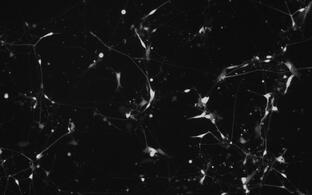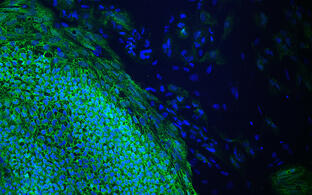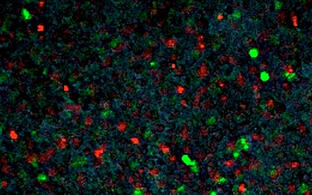Transgenics
Ralf Kühn
Profile
The mouse is the most important model organism for analyzing human genetic disease. Engineering the mouse genome is thus a key technology in biomedical research. In “knock-out” mice, genes become inactivated, which allows their essential function to be tested. In “knock-in” mice, on the other hand, gene sequences are replaced or inserted, enabling researchers to mimic human disease mutations or study how specific genes are expressed in the cell.
Targeting mouse genes to elucidate human disease processes
We use a powerful enzymatic technique, known as CRISPR-Cas9, to generate new, genetically modified mouse lines. The approach was named “2015 Breakthrough of the Year” by Science magazine. The CRISPR-Cas9 method allows the genome to be easily cut and altered at highly specific locations. To achieve this, CRISPR-Cas9 reagents are injected into single-cell mouse embryos, and gene editing is then achieved through natural DNA repair mechanisms, leading either to gene inactivation (with loss of short genetic sequences) or to precise sequence modifications (with an artificially constructed DNA molecule serving as a template for repair).
The Transgenic Core Facility offers advice on the preparation of suitable CRISPR-Cas reagents, and performs the embryo isolation and microinjection as well as their transfer into foster females. Of the pups derived from single-cell embryos microinjected with CRISPR-Cas9 reagents, we usually achieve success rates of about 50 percent for sequence deletions and of about 15 percent for sequence replacements.
Our services also include reproductive techniques for the preservation of precious mouse lines. One important approach is the cryopreservation of sperm and embryos in liquid nitrogen. This helps to save animal housing resources when strains are not actively being used for research. It also prevents gene drifting and excludes loss of colonies in case of infection. When required, thawed sperm samples can be used for in vitro fertilization of mouse eggs, with the resulting single-cell embryos being transferred into foster females. The same in vitro technique, which enables hygienic rederivation of specific strains, is also deployed for the pathogen-free import of mouse lines from external repositories.
Engineering a universal transgenic construct
Many mouse genes are active only in some specialized cells, organs, or developmental stages. A notable exception is a genetic locus (a specific location on a chromosome) known as Rosa26, which is active in all tissues, whatever the subject’s age. Transgenic constructs integrated into Rosa26 are universally active too, which makes it highly valuable for medical research. More than 500 Rosa26 knock-in mouse lines have been generated so far. The Transgenic Core Facility, in collaboration with another group at the Max Delbrück Center, was first to demonstrate the insertion of transgenes into Rosa26 using the CRISPR-Cas9 technology. The resulting strain facilitated gene editing in somatic cells, thereby aiding the analysis of somatic cell disorders. Today, this transgenic mouse line (known as C57BL/6) is distributed via the Jackson Laboratory, a nonprofit biomedical research institution in the United States, which is one of the largest sources of genetically defined mice.
Our tools
- Microinjection of single-cell embryos
- Microinjection of embryonic stem cells into blastocysts
- Embryo transfer
- Sperm freezing
- Embryo freezing
- In vitro fertilization
Team
Service and Technology
Targeting mouse genes to elucidate human disease
To generate new genetically modified mouse lines, we use a powerful enzymatic technique, known as CRISPR/Cas9 system. The approach was elected as breakthrough of the year 2015 by the Science Magazine. The CRISPR/Cas9 method allows cutting and altering the genome at highly specific locations in an easy way. For that, CRISPR/Cas9 reagents are injected into one-cell mouse embryos. The gene editing is then achieved through natural DNA repair mechanisms leading either to gene inactivation (with loss of short genetic sequences) or to precise sequence modifications (with an artificially constructed DNA molecule serving as a template for repair).
The Transgenic Core Facility offers advice for the preparation of suitable CRISPR/Cas reagents; it performs the embryo isolation and microinjection as well as their transfer into foster females. Among the pups derived from one-cell embryos microinjected with CRISPR/Cas9 reagents, we usually achieve success rates of about 50 percent for sequence deletions and of 15 percent for sequence replacements.
Additionally, our services encompass reproductive techniques for the preservation of precious mouse lines. An important approach is the cryopreservation of sperm or embryos in liquid nitrogen. It helps to save resources in the animal housing when strains are not actively used for research; it prevents gene drifting; and it excludes loss of colonies in case of infection. When required, thawed sperm samples are used for in vitro fertilisation of mouse eggs, with the resulting one-cell embryos being transferred into foster females. The same in vitro technique, which enables hygienic rederivation of specific strains, is also deployed for the pathogen-free import of mouse lines from external repositories.
Publications
News
Research
Engineering a universal transgenic construct
Many mouse genes are active only in some specialized cells, organs or developmental stages. A notable exemption is a genetic locus (a specific location on a chromosome) known as Rosa26 that is active in all tissues and throughout all ages. Transgenic constructs integrated into Rosa26 are universally active too, which makes it highly valuable for medical research. More than 500 Rosa26 knock-in mouse lines have been generated so far. However, the Transgenic Core Facility, in collaboration with another group at the Max Delbrück Center, was first to demonstrate the insertion of transgenes into Rosa26 using the CRISPR/Cas9 technology.
The resulting strain facilitated the gene editing in somatic cells, thereby promoting the analysis of somatic cell disorders. Today, this transgenic mouse line (known as C57BL/6) is distributed via the Jackson Laboratory, a nonprofit research institution in the USA and one of the largest sources of genetically defined mice.








